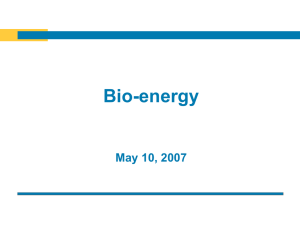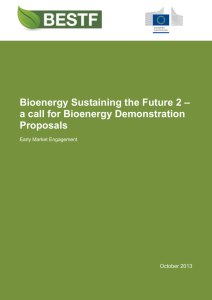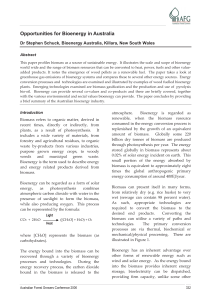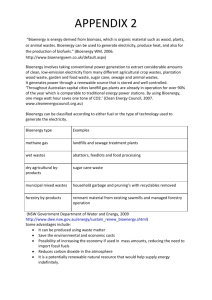First Project Task Force Meeting 21 Feb 2007
advertisement
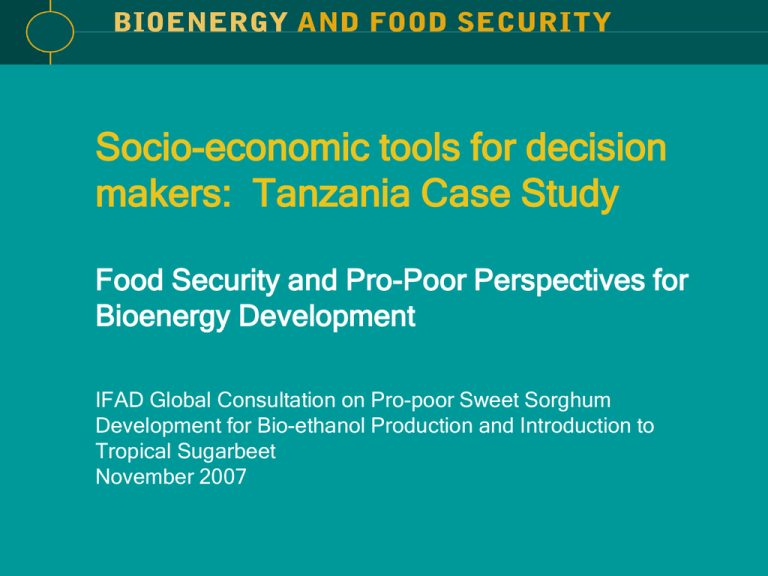
Socio-economic tools for decision makers: Tanzania Case Study Food Security and Pro-Poor Perspectives for Bioenergy Development IFAD Global Consultation on Pro-poor Sweet Sorghum Development for Bio-ethanol Production and Introduction to Tropical Sugarbeet November 2007 Purpose Perspectives on a pro-poor analysis for bioenergy contexts Food insecurity and links to poverty and vulnerability Background and definitions Discuss food security, food security indicators and risks and opportunities Tools for food security and vulnerability analysis Country Typologies as key starting point, current contexts and lessons in hunger reduction Tanzania Case Study BEFS Project Partner Socio-economic Tools – macro-economic, food security and energy Current bioenergy context – potential feedstock, stakeholders, constraints, concerns Conclusions What is food security? Food security exists when all people, at all times, have physical, social and economic access to sufficient amounts of safe and nutritious food that meets their dietary needs and food preferences for an active and healthy life Four dimensions: Availability, Access, Stability and Utilization Time dimension? Chronic food insecurity is a long term and persistent inability to meet food requirements Transitory food insecurity is a short term or temporary inability to meet food needs What is vulnerability? Frequency and intensity of shocks affecting households and capacity to withstand shocks Chronic food insecurity reduces household and community capacity to withstand shocks Who are the hungry? Countries in Transition 25 Sub-Saharan Africa 206 Near East and North Africa 38 Latin America and the Caribbean 52 Developed Market Economies 9 854 million 820 developing countries Asia and the Pacific 524 212 million India 150 million China Where are the hungry? 20 to 34% UNDERNOURISHED Bangladesh Bolivia Botswana Cambodia Cameroon Congo Dom Rep Gambia Guatemala Guinea Honduras India Kenya Laos PDR Malawi Mali Mongolia Namibia Nicaragua Niger Pakistan Panama Senegal Sri Lanka Sudan Thailand Togo > 35% UNDERNOURISHED Angola Burundi CAR DRC DPRK Eritrea Ethiopia Haiti Liberia Madagascar Mozambique Rwanda Sierra Leone Tanzania Tajikistan Yemen Zambia Zimbabwe FOOD AND ENERGY SECURITY ASSESSMENTS? Opportunities Risks Food Security Indicators •Diversification and/or increased income from feedstock crops •Infrastructure development and employment (rural) •Improved land use and increased access to factor inputs •Diversification of domestic energy supply •HH energy burden reduced for women and children •SME energy access improved •New technological advances •Climate change mitigation •Revenue from payment for environmental services and monetization of carbon credits •Decreased access to food due to price increases driven by competition for biomass for energy versus food •Decreased food availability due to replacement of subsistence farm land by energy plantations •Increased environmental pressure due to introduction or expansion of unsustainable bioenergy systems (H20 pollution, loss of biodiversity, land degradation) •Pressure on prices of other goods and services related to land-use and biomass •Cash cropping systems could alter intra-HH food security •Proportion of chronically undernourished (<5 stunting) •Adult literacy (+female) •Proportion of HH income to food (access) •Proportion own production of food (availability) •Population growth •GDP growth per capita •Agricultural contribution to GDP growth (%) •Adult HIV population •Number of food emergencies (stability) •Degree of import or export dependence (self-sufficiency) •Access to water and sanitation facilities Source: FAO Bioenergy and Food Security Project Proposal (2006) Types of food security, livelihoods and vulnerability analysis? Food frequency and diversity score Coping Strategy Index Phases and scales combine hard and soft indicators (FAO/FSAU or Famine Scales) Household Food Economy Approach Household Expenditure Surveys Judgment-based Classification Household Self-Assessment Country Typologies - Key Starting Point Preliminary analysis - base in typologies Developing, LIFDCs and LDCs Positive extreme – traditional net exporter of food and energy (Indonesia or Malaysia) Negative extreme - net food and energy importer (LDCs and Near East) Poor spend high % HH income on food 33% of rural SSA HHs headed by women, lacking access to factor inputs, affected by environmental degradation, water and fuel shortages Cash crops can alter HH food security Prices, biofuels and food security Rising commodity prices – positive for producers and negative for poor consumers Clear linkages - fossil fuel prices and food crop feedstock Price increases in major biofuel feedstock markets (sugar, molasses, corn, rapeseed oil, palm oil and soybean) Additional uncertainty (biofuel mandates) Factors of exclusion and value chain considerations Environment, bioenergy and climate change Trade-offs need analysis, particularly related to food security impacts Local issues related to access and control of natural resources Global level, climate change impact most direct link to food security Increased frequency and severity of weather shocks Policy domains shape bioenergy and food security impacts Rural policies favor large-scale commodity and livestock production Increased competition for resources and inputs to agriculture Factors of exclusion need to be addressed Attention to agriculture in rural areas necessary Maintaining national and household level food security remains priority for most developing countries Lessons in hunger reduction Applicable to bioenergy development? Agricultural growth is critical Safety net programs are crucial Peace, stability and good governance essential Development assistance needs better targeting Bioenergy and Food Security Project www.fao.org/NR/ben/befs Why Tanzania as BEFS Partner? Four criteria for project partners: (1) the energy sector and bioenergy options in the country (2) Food security dimensions (3) General country characteristics (4) Institutional and governance issues Tanzania Source: FAO Tanzania: Some Key Indicators Economic Indicator 2005 GDP/Capita (Constant 2000 USD) 330 GDP/Capita (Constant 2000 Int$, PPP) 662 GDP Growth 7.0 Agriculture Value Added per worker (Constant 2000 USD) 303 Agriculture Share 44.5 Percent of rural population 75.8 Source: WDI 2007, UNDP Food Security and Poverty in Tanzania Year of Reference Variable Population (millions) 2001-2003 36.3 Percent of undernourished 2001-2003 44 Import dependency ratio (% cal basis) 2000-2004 10 Self-sufficiency ratio for cereals * 2004 85 Poverty gap at 1 USD a day (PPP), Percent 2000 20.7 Poverty gap at 2 USD a day (PPP), Percent 2000 49.3 Adult literacy rate, female (age 15 and older) 2005 62.2 HIV Prevalence (% age 15-49) 2005 6.5 Key Indicators Source: FAOSTAT 2006, SOFI 2006, WDI 2007, UNDP; * calculated Energy Profile of Tanzania Current energy mix Approximately 90 percent biomass, mostly woody Petroleum and electricity: 9 percent Other sources 1 percent Low level technologies Low level of electrification What bioenergy feedstock are under consideration? Bioethanol: Sugarcane, Sweet sorghum, Cassava, Sissal Biodiesel: Jatropha, Palm oil, Sunflower Who is currently involved? Government: Ministry of Agriculture, Ministry of Energy, and other related sections University and research Companies - Sunbiofuels, Diligent, Infenergy, Kitimondo plantations, SEKAB, British Petroleum UN organizations and NGOs Who are the major stakeholders? Rural populations, smallholders, outgrowers - less efficient smaller scale Private sector investors – capital to invest and larger scale Plantation model could worsen social and economic exclusion, however.............. Dependent upon contractual arrangements, structure and adherence to policy/mandates TANZANIA - FOOD AND ENERGY SECURITY ASSESSMENT Opportunities Risks Food Security Indicators •Diversification and/or increased income from feedstock crops •Infrastructure development and employment (rural) •Rural electrification could reduce HH energy burden for women and children •Improved land use and increased access to factor inputs •Diversification of domestic energy supply •SME energy access improved •New technological advances •Climate change mitigation •Revenue from payment for environmental services and monetization of carbon credits •Current factors of exclusion not addressed •Government/policy risk •Cash cropping systems could alter intra-HH food security •Decreased access to food due to price increases driven by competition for biomass for energy versus food •Decreased food availability due to replacement of subsistence farm land by energy plantations •Increased environmental pressure due to introduction or expansion of unsustainable bioenergy systems (H20 pollution, loss of biodiversity, land degradation) •Pressure on prices of other goods and services related to land-use and biomass •38% chronically undernourished (<5 stunting) •76% population in rural areas •44% agricultural contribution to GDP growth •62% Adult female literacy •90% HH energy wood biomass •Proportion of HH income to food (access) - HBS •Proportion own production of food (availability) – HBS and food security assessments •1.8% Population growth •7% GDP annual growth, 5.3% annual growth in agriculture •6.5% Adult HIV population •Relatively few food emergencies (stability) •85% self-sufficiency (cereals) •62% access to water and 47% sanitation facilities Source: FAO Bioenergy and Food Security Project Proposal (2006) Constraints to private sector investment Legislation No legislation in place for Bioenergy National Bioenergy Task Force Land Tenure All land owned by state Released to villages, state, individuals Infrastructure Very limited number of roads Bioenergy proposals always close to existing infrastructure (road or railroad) Constraints to poor rural populations Extreme poverty and access to credit Remoteness and geographic isolation Rural Infrastructure Gender considerations – moving from subsistence crop for HH use to cash crop alters (negatively) HH food security Further Analysis? Micro Level Tools Quantitative work on HH surveys, reliant on existing information on sweet sorghum or jatropha Focus on availability and food access data Current energy use, income and food sources Macro Level Tools Energy profile, internal versus external demand, market and trade issues Potential returns on investment Value chain perspectives and land tenure Conclusions Who are the poor and most food insecure relative to bioenergy development? Identify and respect national priorities about food security and self-sufficiency (maize) Land and legislation could be serious hurdles to bioenergy investment No policy/mandate implies no internal market outlet Resolve potential conflict over access and control of natural resources Source of income and energy Create incentives for reinvestment Stimulate domestic economy and rural development

